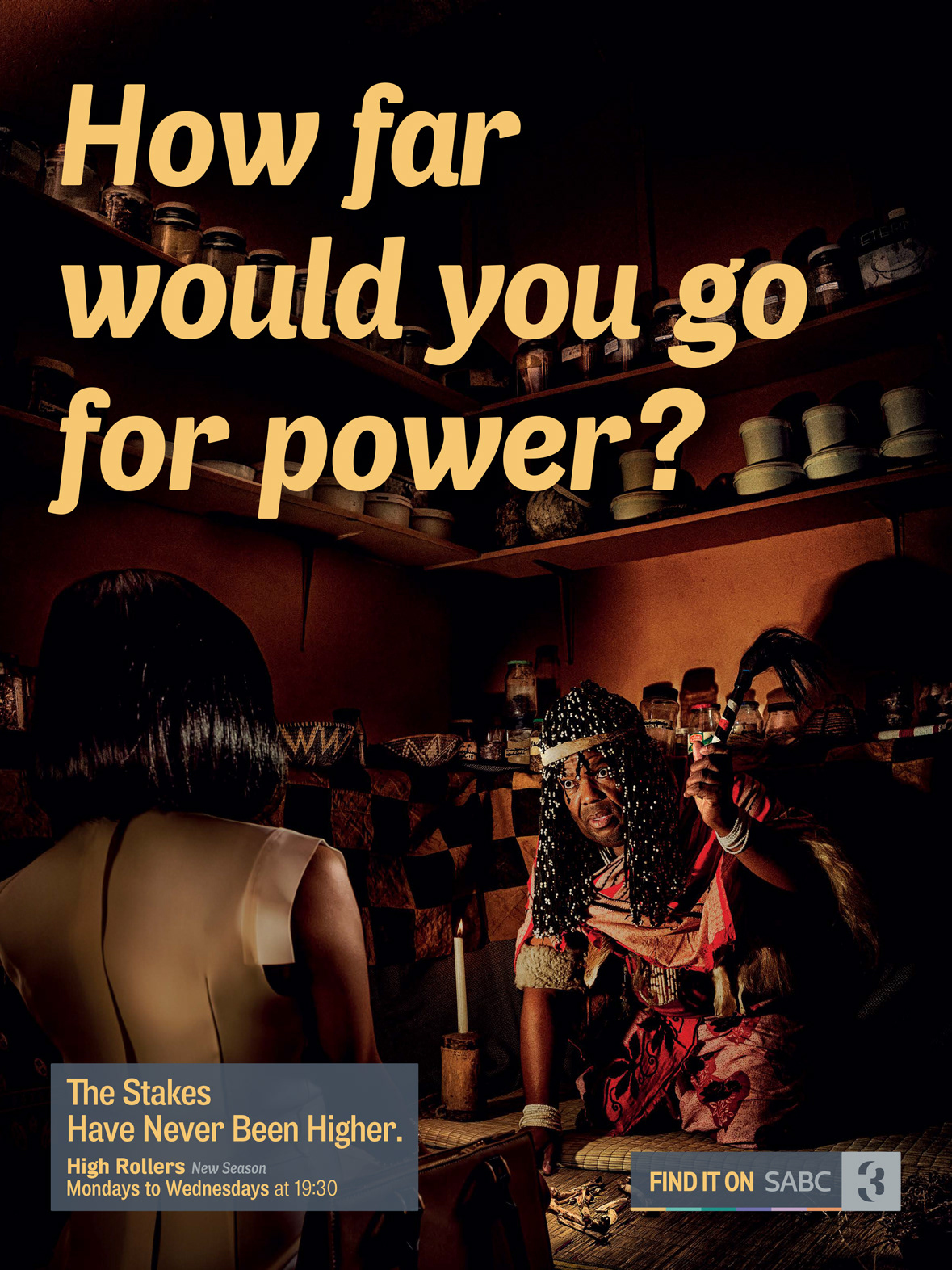Master’s Thesis Project stems from observing and documenting at close range (and researching historically) a seemingly impermeable cycle of occupation, violence and
abandonment within the inner-city, whose roots stretch back over the past 130 years. The cycle has culminated, at the present time, in the ‘writing off’ of a number of
inner-city buildings as ‘bad buildings’ not fit for habitation or study and yet, remains an epidemic that threatens to destabilise so many South African cities.
However, this is certainly not only a South African problem. In January 2018 the world’s population was 7.6 billion; this number will increase to 11.2 billion by 2100. The
world’s urbanised population was 30% in 1950, 50% in 2014, and is projected to be 70% in 2050. Approximately 1 in 6 of the world’s population currently lives in ‘slums’
and, similarly, that number will increase to 1 in 3 by 2025. It is clear that our cities are now critical considerations.
living in 1305 of these buildings means that a total population of anywhere between 2-to-800 thousand people are affected, and living in critical conditions below UN
refugee guidelines.
no electricity, no toilets, no refuse removal, one water pipe, two storeys flooded with water, three storeys high of trash–and almost 250 inhabitants. It tracked alarming
statistics; delved into the murky relationship between those on the first rungs of urbanisation and those who’ve slipped below. Therefore, spaces like ‘Dark City’ required
an alternative means of representation—achieved by engaging contributors in fine art, photography, film, research and sociology and using participative and collaborative
techniques with the inhabitants of ‘Dark City’ to determine what design, representation and architecture are in these spaces and places.
the research, findings, experiences, emotions, harsh realities and hazardous environments of the building ‘Dark City’—but particularly the lives of the people that live
there. The collection of works were curated by Hariwe and were illustrated and composed in several visual art media. This included documentation, drawing, conceptual
art, installation art, historical drawing, photography, cinematography, video art- and was showcased by the three primary project contributors : Hari(we), Jono Wood and
Dirk Chalmers.
which were researched for approximately three years. During this time, I worked with many different people from all over Africa, many different languages, backgrounds,
journeys, ages, socio-economic statuses, political agendas, races, experiences of xenophobia and violence, and so on. This personal pliability allowed me to connect with
many different cultures and people – in a concentrated context.
[Medium] [Collage] Mixed-Media (coffee and watercolour stained Fabriano, 3D modelled collaged prints with fine-liner & graphite pencil hand drawings, all scanned and printed on 300gsm (140 lbs.) Tecco Bright White Fine Art Rag framed in blackened and damaged African Walnut.
[Medium]
[Installation] Personally Collected and hand-washed inner-city Refuse (600 x cans, 400 x plastic soda bottles, 5 x tyres, 750 x discarded refuse plastic packets, 1 x 2m x 1m rusted steel mattress, 6 x discarded female weaves, 3 x discarded vehicle registration plates, 6 x boxes of broken blood-stained glass, 1 x 5l bucket of mud and stones, 1 x 5l bucket of ash – all encased in mild-steel frame, with 12mm chipboard walls painted black, with 3mm clear Perspex covers.
[Rationale]
This Installation replicates the volume and severity of discarded refuse inside and outside of ‘Dark City’. The four walls are designed to convey the real sense of physical imprisonment and enclosure of refuse that blocks fire escapes, circulation routes, elevator shafts, entire floors and even open pieces of land between adjacent properties. Viewers enter the installation and experience 3.8m high of refuse that represents just one floor height of the Dark City Building’s four floors of refuse. Well-heeled gallery viewers were forced to contemplate what the total height of 13.2m high of refuse would be like.
Collected burnt debris after the petrol-bombing of building by vigilante surrounding communities on 08 August 2014, laser-cut Perspex, laser-cut 1.2mm grey, spray-paint, shards of mirror, mild steel nails and screws, machine grease, white LEDs – within timber and Perspex cabinet, with hidden posterior power-cable shelf.
[Medium] [Photographs taken by inhabitants] Print on 300gsm (140 lbs.) Tecco Bright White Fine Art Rag framed in blackened and damaged African Walnut.
[Rationale]
This artwork explores the process of collage through personal exchange, which forms a sectional drawing through the relationship between the building and its inhabitants of the Dark City building over 1 year.
This way of working responds to the authorship of representation of this building and how socially-focused artists should be working. It compresses the stories of how people live in the inner-city today into one drawing of many scenes. To achieve this, I handed out 6 disposable cameras with a written request list (translated into Zulu and Shona) of each inhabitant’s lived space.

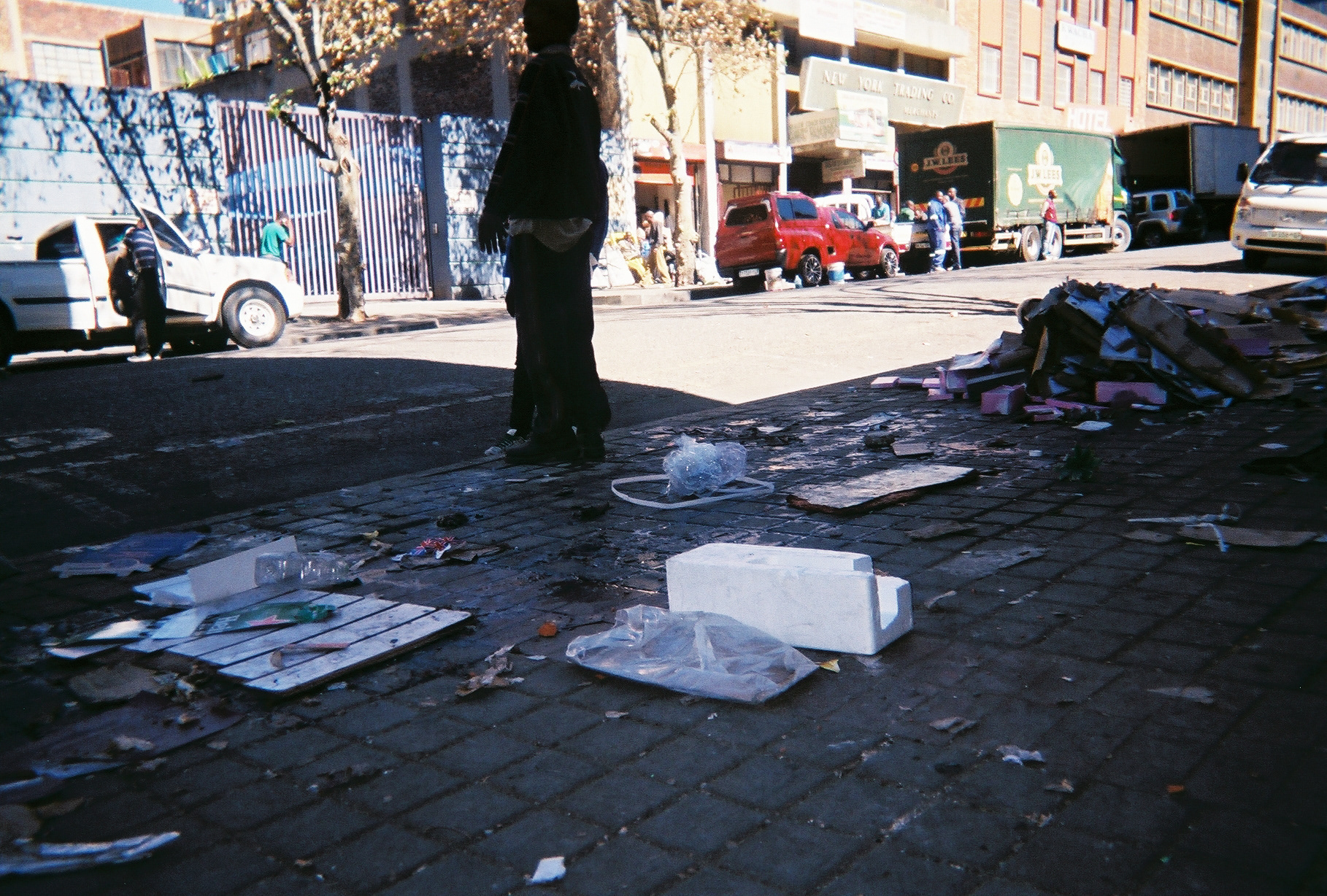




[Medium] [Story-telling, Drawing + Photographs - Jono Wood] Sihl Persomural 170gsm Prints mounted on 5mm foam-board within mild steel frames made and welded by inhabitants.
[Rationale]
This artwork captures what has cyclically happened to the inhabitants: in their lives, in this city, in this precinct, and in this building - in the physical-scale of the inhabitants’ hands in the time-scale of a human’s life.
‘Hand Portraits’ compresses the occurrences of a person’s life into layers of photography and stories.
I rejected the typically static and stagnant drawings that architecture produces. I wanted a drawing that could become a sculpture; so viewers could touch the unknown, and touch people they would normally never meet or interact with. I leaned the structures over to disrupt personal space. The frames were designed by me but I commissioned them to be welded by the inhabitants of Dark City.
‘Hand Portraits’ was designed to create introductions and conversations with, and about, the inhabitants, the building, and many other clues that come from our hands. These include where we’re from, what we do, where we’ve been, what has happened to us etc.
I began the process by introducing myself and using an annotated photograph of my own hand at first, using it as a sharing and discussion tool that could, in the beginning, negate direct questioning that felt less interrogation-like. For this reason, the ‘Hand Portraits’ are useful in that they are far less direct and intimidating in that they are not of a person’s face; they can tell stories but they have far more anonymity and an ethical means of research and story-telling.
[Medium] [Sculpture] – mixed media: Perspex, tubing, syringes, white cotton, laser-cut 1.2mm grey, spray-paint, and white LEDs.
[Medium] [Collage] Mixed-Media (collected animal bones & skins, feathers, spider webs, burnt timber, ash, peeling paint, gravel – all scanned and collaged with and photographed graffiti, damaged plaster and concrete, all combined into 3D modelled collaged prints with fine-liner and graphite pencil hand drawings, all scanned and printed on 300gsm (140 lbs.) Tecco Bright White Fine Art Rag framed in blackened and damaged African Walnut. This drawing-collage is of Dark City at a scale of 1:70.
[Process] I visited the building every Friday for 18 months; 3 hours per visit. Each visit I would spend on one floor, draw it all by hand and collect objects and textures for scanning, and then progress upwards to the floor above. This collage constitutes one years’ worth of work and weeks’ worth of collecting and drawing and collaging.
[Rationale]
This work is a sectional cut through the building known as DARK CITY, located in downtown Johannesburg.
It once existed in Doornfontein before the people were brutally evicted in 2016 after nearly twenty years of violent police raids.
This exploration of collage compresses the layers of the building’s 70 years of existence into one scene.
[Medium] [Photograph + Digital Illustration] printed on 300gsm (140 lbs.) Tecco Bright White Fine Art Rag framed in African Walnut.
[Medium] [Sculpture] Resin, MDF, collected animal and insect bones & skins from the interiors of Dark City (including 3 kilograms of spider webs, 2 skinned rats, 1 skinned rooster and feathers, abandoned bird and spider nests), South African bank notes, candle-wax, paint, burnt debris, all on Spiral-bent mild-steel Y16 Rebar
[Rationale] This sculptural piece collates the observed and documented cyclical changes of the ‘Dark City’ building from 1947 to 2016 compressed into one life-world. The cyclical repurposing of the building has been exploded and separated, chronologically, so that one may view each of the layers of the building’s life-time. This forms the third exploration of cyclical collage (in the series): exploded and separated.

"Tired Of Being A Donkey" 2004-2016 Photographic Print Fine Art Cotton Fibre A1. Writing on a wall in Dark City reads 'Tired of being a donkey' the image reflects the manner in which immigrants and unskilled labour are exploited in South Africa.The exploitation of labour adds to the growing of an unequal society and pushes many disadvantaged people into living conditions such as Dark City.

Curtain 2014 - 2016 Photographic Print Fine Art Cotton Fibre A0. A curtain hanging against a decaying wall in Dark City portrays the desire of a home even in the most undesirable living conditions.Many people call Dark Buildings home as there can be very little other choice available.
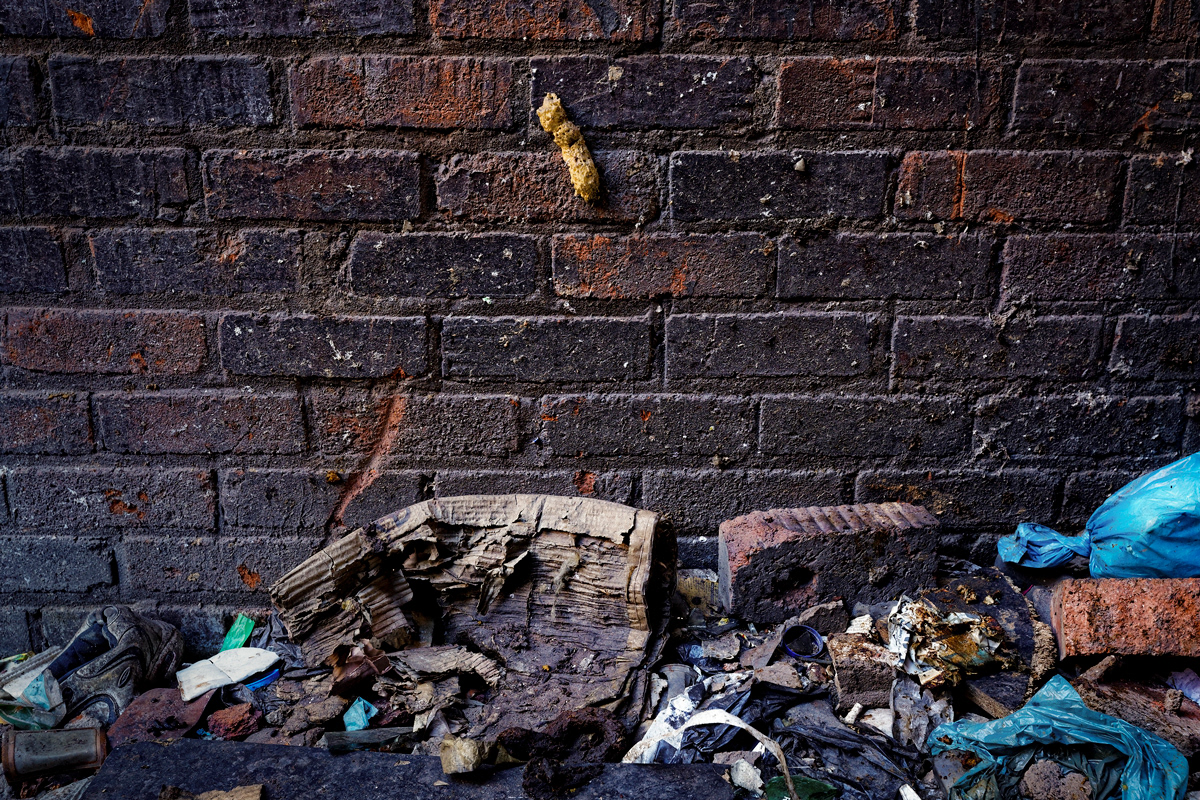
Shit On Wall 2014 - 2016 Photographic Print Fine Art Cotton Fibre A1. Living conditions are incredibly difficult for residents of dark buildings without running water and electricity. Residents use buckets overnight as toilets and at dawn the contents are discarded out of windows, down elevator shafts or onto fire escapes.
Ground Floor Trash 2014 - 2016
Photographic Print Wallpaper 2,5m x 3m
Dark buildings are often used as illegal dumping sites and combined with waste created by residents trash quickly piles up. The trash swallows these buildings floor by floor as all unused space is now for discarding of trash.

Stairway To The Cathouse 2014-2016 Photographic Print Fine Art Cotton Rag A0. The entrance of a dark building now opperating as a brothel stands pink with crosses scratched into the walls on either side of the staircase. Ladies charge R25 per customer of which R5 goes to the 'Landlord' who owns the room in the building they work from. The 'owner' bought the room for R400 from a building Hijacker.

Ground Floor Shacks 2014 - 2016 Photographic Print Fine Art Cotton Rag A1. Three shacks share supporting walls on the ground floor of Dark City. A damaged water pipe has flooded the basement, which was completely inaccessible and filled with trash. The water had begun flooding the ground floor and homes built there.

Elevator Shaft 2014-2016 Photographic Print Fine Art Cotton Rag A0. The elevator shaft of Dark City was filled with four stories of trash including the basement and elevator pit. All metal had been stripped from the elevator to be sold as scrap metal. Residents using the shaft as a rubbish dump would throw their trash into the elevator shaft but some items would get stuck on the few pieces of metal sticking out of the wall and remain eerily suspended.
Blue Stairs 2014-2016
Photographic Print Fine Art Cotton Rag A0.
A Fire Escape in Dark City is used as a place to throw trash generated by residents from the building.Trash on the stairs collected almost as high as a tire standing vertically, illustrating the vast amount of waste created by humans and the terrible affects of trash removal services not being available to the building. This image speaks to the city's abandonment of Dark Buildings allowing them to rot internally instead of providing solutions to improve the lives of those in and around Dark Buildings.

A Womans Possessions 2014 - 2016 Photographic Print UV Print, Lightbox 850mm x 850mm. Two woman's purses lie on the ground floor of Dark City as a result of muggings. A Nedbank money bag lies amongst the possessions showing us a bag that most likely contained someones monthly salary. The discarded possessions have started to decay with the rest of the building as if nature is taking it's course and the reoccurrence of this act is imminent.

Jet, Thank You 2014 - 2016 Photographic Print UV , Lightbox 850mm x 850mm. A Capitec bank card and Jet loyalty card lie on the ground floor of Dark City as the leftovers of a mugging by Dark City criminals. Thank you written on the Jet card is a cynical comment when the card is no longer visualised in the retail space but rather in the ruins of a dark building.
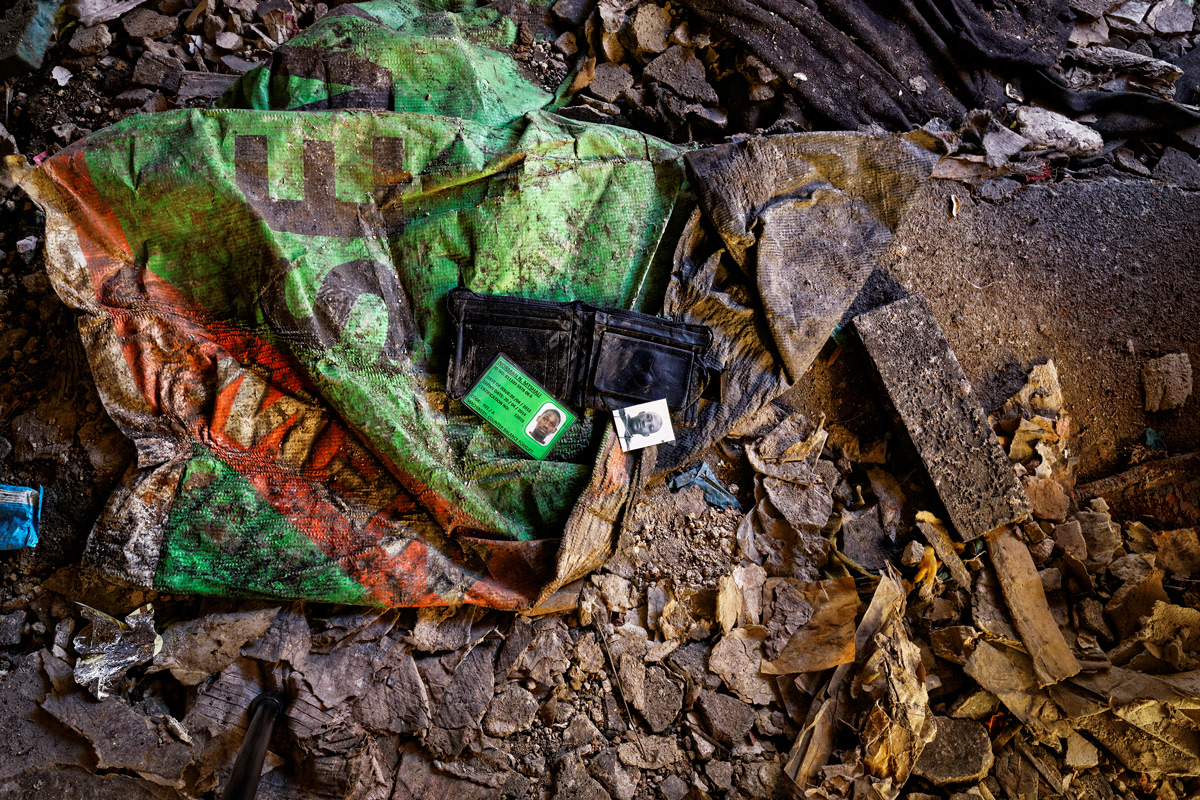
Norman The Forlkift Driver 2014 - 2016 Photographic Print UV Print, Lightbox 850mm x 850mm. The victim of a mugging's wallet lies on the ground floor of Dark City. His permit card to operate a forklift lies next to his ID photograph. The wallet has clearly been sorted through and abandoned in an eerily reflective manner of its former owner. This image speaks about crime in Dark City.
Pulling A Load
2014 - 2016
Suspended Photographic Print
210gsm Tecco Semi Matte, Face mounted 3mm perspex A1
James a Zimbabwean immigrant pulls a heavy load of recyclable cardboard to a nearby depot. He spends his days collecting recyclable materials around the city often working odd jobs cleaning in exchange for bottles or boxes.

Enter Dark City 2014- 2016 Photographic Print Fine Art Cotton Rag A1. The entrance of Dark City photographed on the night an angry mob of residents from the surrounding flats attempted to burn down the building with petrol bombs. The entrance of Dark City was enough to stop persuers following a mugger back into the building and was very much a barrier to those unaccustomed to Dark City. It was also used for ambush and a victim would be pulled into the building to be mugged of everything including their shoes.

Gun Shot 2014 - 2016 Photographic Print Fine Art Cotton Rag A1. A young Zimbabwean man sits on a wall in Dark City with a bullet wound through his leg. During an interview he said he was shot in crossfire by the police and wouldn't get medical attention due to fear of being deported.

Lonely Child 2014 - 2016 Photographic Print Fine Art Cotton Rag A1. A toddler wonders the halls of a dark building, his mother was a heroine user and dealer. She explained in an interview how other residents abuse the boy when she is not around to show their distate towards her behaviour.
Water for Weight 2014 - 2016 Photographic Print Fine Art Cotton Rag A0.
James a Zimbabwean immigrant wets cardboard to load onto a trolley, wetting the cardboard allows him to transport many loads of collected cardboard in a single journey, these trips can weigh up to 150kg.

Zimbabwean Boy 2014 - 2016 210gsm Tecco Semi Matte, Face mounted 3mm perspex A1. A young Zimbabwean boy stands for a portrait and tells me how he thought he was going to be rich in Johannesburg. He had left to Johannesburg without his mothers consent and now wanted only to return home. Many immigrants told me of how they expected to earn a lot of money in Johannesburg and be able to send money home to their families but in reality were struggling just to survive.

Reading A Porno 2014 - 2016 Photographic Print Fine Art Cotton Rag A0. Two women sit next to a fireplace on the sixth floor reading a porno magazine, the second woman chose to hide her identity in the photograph by lifting the magazine infront of her face.
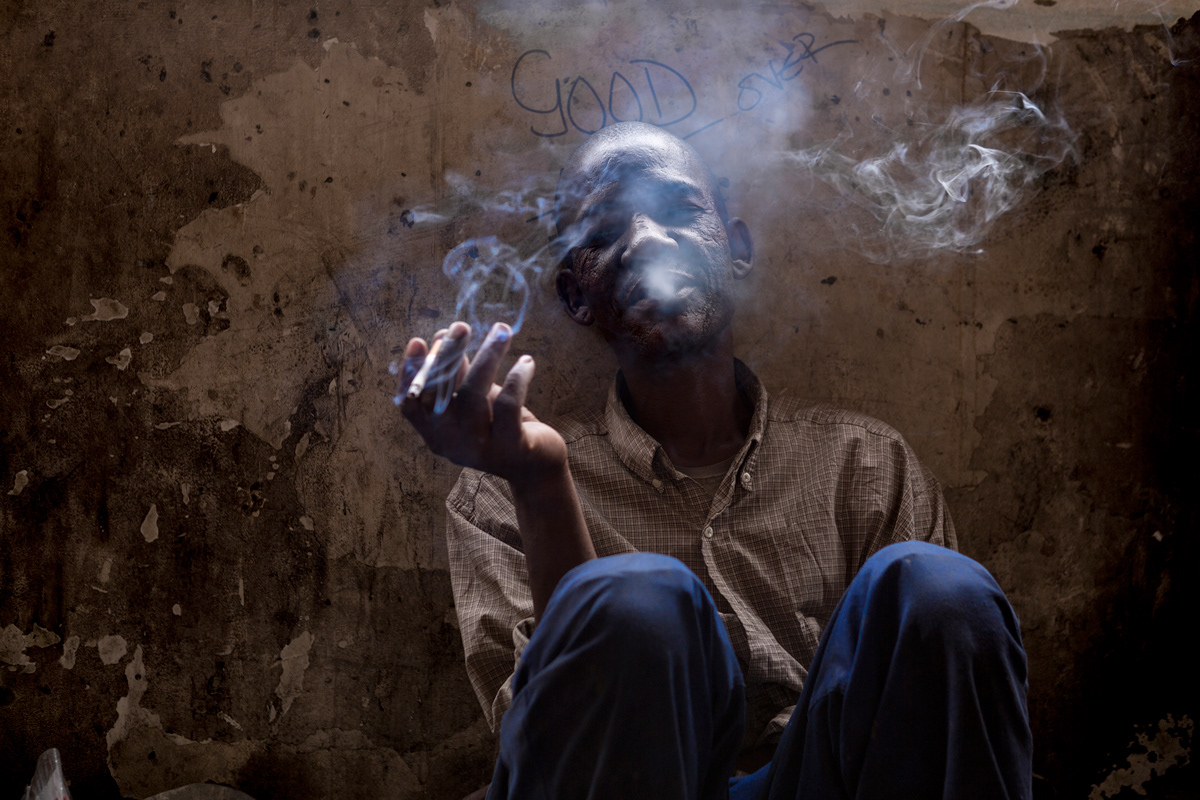
James, Low Portrait 2014 - 2016 Photographic Print Fine Art Cotton Rag A1. Portrait of James an immigrant from Zimbabwe resting against a wall smoking a cigarette in Dark City.
P.I.M.P 2014 - 2016 Photographic Print Fine Art Cotton Rag A1.
Thabo stands on a staircase in a dark building used as a brothel, he currently lives in and manages the day to day running of the building. The building is operating as a brothel without access to running water or electricity posing a very real health issue to Sex Workers. A small room with two broken mattresses separated by a curtain is where the exchange of sex for money takes place, the floor is littered with used condoms.

Recycling Outside Dark City 2014 - 2016 Photographic Print Fine Art Cotton Rag A1. A man recycles boxes on a street corner outside of Dark City. The fire in the background is from burning of cables to sell copper for scrap metal.

Trash Collector 2014 - 2016 210gsm Tecco Semi Matte, Face mounted 3mm perspex A1. A Zimbabwean man stands in the entrance of Dark City ready to begin a days recycling, many immigrants become recyclers in Johannesburg to make an income.
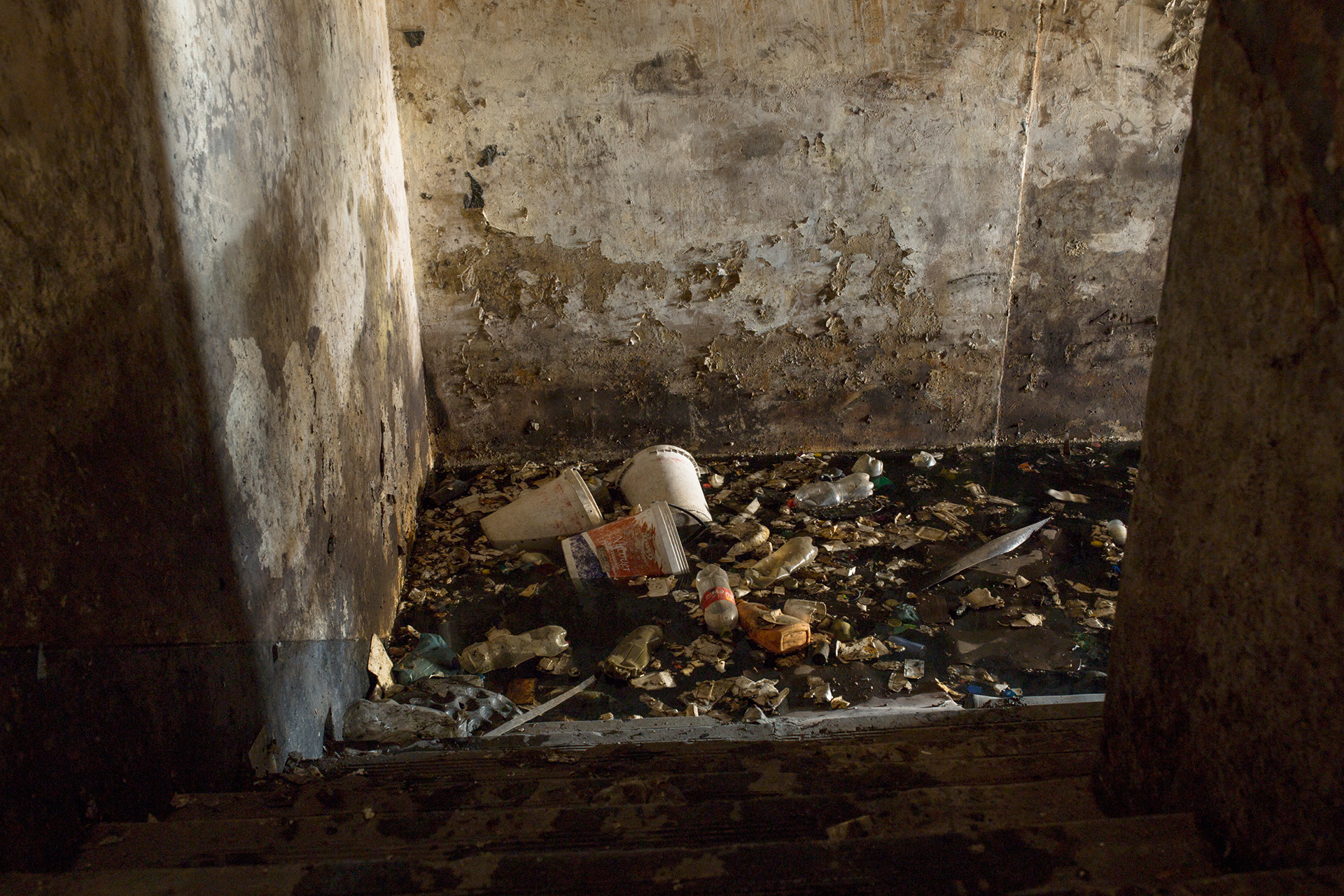
Basement 2014 - 2016 Photographic Print Fine Art Cotton Rag A1. After construction began the basement was being drained of water and trash was being removed. In the process two decaying bodies were pulled from the rubbish each decapitated and cut in half at the torso.
Excavation 2014 - 2016 Photographic Print Fine Art Cotton Rag A1.
The ground floor after construction had begun and the trash was removed, two men look into a hole in the ground leading to the basement once inaccessible, filled with trash and flooded with water.





